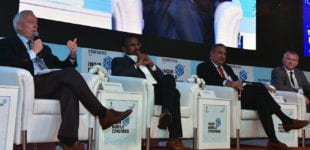October 16, 2018
Smart city technologies have been getting a lot of attention in recent months. After all, they stand to make cities better places to live, and may make them more sustainable.
Adding wireless sensors to everything from roads to pipes relies on what have become simple, low-cost technologies. But don’t be deceived by the simplicity of the sensors – this new wireless network will drastically shift the workflow of city management.
According to research published in IEEE Electrification Magazine, “Historically, urban infrastructures have been planned independently and operated individually, leading to domain-specific silos that lack flexibility and interoperability in providing services to citizens.” Now, this wireless data can help city authorities make decisions quickly, proactively and with unified information.
Central to the overall function of these low-cost sensors is the use of the cloud. To the researchers from the Illinois Institute of Technology, “Cloud computing allows data to be retrieved and processed in real time, which offers a convenient way to perform big data analytics.” And best of all for municipalities, it’s cost-effective. But these upsides are dependent on the data being structured and timed in ways that are consistent.
One big challenge in this endeavor is that because utilities are fundamentally different and their control systems private and domain-specific, the data generated by sensors can be structured quite differently. This creates a roadblock for cloud computing.
The researchers see the answer to this problem in edge computing.
So, what exactly is edge computing? In short, rather than taking place in a centralized cloud, computing is first conducted locally on a network of distributed devices. Once the heaviest computing is done, processed data can then be sent to the cloud, improving responsiveness and reducing lag. Hence, these devices live at the “edge” of the cloud.
This setup also helps avert issues with data structure.
The researchers still propose that the cloud play a big role here, however. By using a hierarchy that employs sensors and actuators at the field level, local controllers for data capture and edge processing at the area level and full use of the cloud and predictive analytics at the control center level, they believe city authorities can collect and analyze data across disparate infrastructures in real-time.
This availability of data will facilitate planning and decision making, “which can improve city operations, ensure the well-being of citizens and meet the expectations for urban sustainability,” they say.
Shawn Chandler, IEEE Senior Member and Chair of the IEEE Internet of Things Smart Cities Working Group, puts the data transmission challenge more bluntly: “Tackling the communications services and data integration necessary to connect the many infrastructure-related elements of smart cities is a foundational requirement – without it, there is no smart city.”
Free access to this research from IEEE Electrification Magazine (IEEE Power & Energy Society) is provided by IEEE Technical Community Spotlight, a newsletter that shares the latest breaking news from IEEE societies and communities. You can find the latest issue here. Read the full paper before free access ends on December 10th.





 Meaningful Momentum or Running in Place?
Meaningful Momentum or Running in Place? AI Through Our Ages
AI Through Our Ages Liquid Infrastructure: Our Planet's Most Precious Resource
Liquid Infrastructure: Our Planet's Most Precious Resource The Impact of Technology in 2025
The Impact of Technology in 2025 Quantum and AI: Safeguards or Threats to Cybersecurity?
Quantum and AI: Safeguards or Threats to Cybersecurity? Why AI Can't Live Without Us
Why AI Can't Live Without Us Bits, Bytes, Buildings and Bridges: Digital-Driven Infrastructure
Bits, Bytes, Buildings and Bridges: Digital-Driven Infrastructure Impact of Technology in 2024
Impact of Technology in 2024 Emerging AI Cybersecurity Challenges and Solutions
Emerging AI Cybersecurity Challenges and Solutions The Skies are Unlimited
The Skies are Unlimited Smart Cities 2030: How Tech is Reshaping Urbanscapes
Smart Cities 2030: How Tech is Reshaping Urbanscapes Impact of Technology 2023
Impact of Technology 2023 Cybersecurity for Life-Changing Innovations
Cybersecurity for Life-Changing Innovations Smarter Wearables Healthier Life
Smarter Wearables Healthier Life Infrastructure In Motion
Infrastructure In Motion The Impact of Tech in 2022 and Beyond
The Impact of Tech in 2022 and Beyond Cybersecurity, Technology and Protecting Our World
Cybersecurity, Technology and Protecting Our World How Technology Helps us Understand Our Health and Wellness
How Technology Helps us Understand Our Health and Wellness The Resilience of Humanity
The Resilience of Humanity Harnessing and Sustaining our Natural Resources
Harnessing and Sustaining our Natural Resources Creating Healthy Spaces Through Technology
Creating Healthy Spaces Through Technology Exceptional Infrastructure Challenges, Technology and Humanity
Exceptional Infrastructure Challenges, Technology and Humanity The Global Impact of IEEE's 802 Standards
The Global Impact of IEEE's 802 Standards Scenes of our Cyber Lives: The Security Threats and Technology Solutions Protecting Us
Scenes of our Cyber Lives: The Security Threats and Technology Solutions Protecting Us How Millennial Parents are Embracing Health and Wellness Technologies for Their Generation Alpha Kids
How Millennial Parents are Embracing Health and Wellness Technologies for Their Generation Alpha Kids Space Exploration, Technology and Our Lives
Space Exploration, Technology and Our Lives Global Innovation and the Environment
Global Innovation and the Environment How Technology, Privacy and Security are Changing Each Other (And Us)
How Technology, Privacy and Security are Changing Each Other (And Us) Find us in booth 31506, LVCC South Hall 3 and experience the Technology Moon Walk
Find us in booth 31506, LVCC South Hall 3 and experience the Technology Moon Walk Virtual and Mixed Reality
Virtual and Mixed Reality How Robots are Improving our Health
How Robots are Improving our Health IEEE Experts and the Robots They are Teaching
IEEE Experts and the Robots They are Teaching See how millennial parents around the world see AI impacting the lives of their tech-infused offspring
See how millennial parents around the world see AI impacting the lives of their tech-infused offspring Take the journey from farm to table and learn how IoT will help us reach the rising demand for food production
Take the journey from farm to table and learn how IoT will help us reach the rising demand for food production Watch technical experts discuss the latest cyber threats
Watch technical experts discuss the latest cyber threats Explore how researchers, teachers, explorers, healthcare and medical professionals use immersive technologies
Explore how researchers, teachers, explorers, healthcare and medical professionals use immersive technologies Follow the timeline to see how Generation AI will be impacted by technology
Follow the timeline to see how Generation AI will be impacted by technology Learn how your IoT data can be used by experiencing a day in a connected life
Learn how your IoT data can be used by experiencing a day in a connected life Listen to technical experts discuss the biggest security threats today
Listen to technical experts discuss the biggest security threats today See how tech has influenced and evolved with the Games
See how tech has influenced and evolved with the Games Enter our virtual home to explore the IoT (Internet of Things) technologies
Enter our virtual home to explore the IoT (Internet of Things) technologies Explore an interactive map showcasing exciting innovations in robotics
Explore an interactive map showcasing exciting innovations in robotics Interactively explore A.I. in recent Hollywood movies
Interactively explore A.I. in recent Hollywood movies Get immersed in technologies that will improve patients' lives
Get immersed in technologies that will improve patients' lives